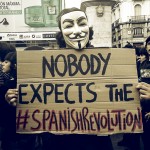Democracy, Crowds and New Media
In Alfred Hitchcock’s The Birds (1963), flocks have acquired some strange way of communicating and coordinating actions. The birds form swarms with a purpose: to challenge the peace of a small town. Mrs. Bundy points out that they should not “have sufficient intelligence to launch a massed attack.” (The Birds)
Along the ensuing violence, the film has a political under-text: the birds are fighting against the ignorant tyrant “mankind” by transcending their non-existence as a group. In the final scene the birds have taken over the place and rule absolutely and mindlessly. The Birds was a film that matched the American political climate of the sixties, with references to the civil rights movement.
Swarms, mobs and crowds, all have the power to exert a great influence and threaten social structures, if they are able to communicate effectively and rapidly to avoid dissipation. In democratic systems, the power of big numbers of people is crucial: the majority that uses power by voting, the minority that exerts influence through opposition in the houses of the legislative system, the civil movements that represent special interests, and of course the crowds of protesters and the populist movements. And the “shadow crowds,” the police and the army.
Communication technologies, when used by crowds, tends to create the illusion that the individual in the crowd can regain a voice lost to the powers that create a putative authority over them, because their voice cannot be made heard without incurring significant cost and exertion. The new found “voice” came with the advent of the printed book, the telegraph, the telephone, and more recently the cell phone and the Internet.
An interesting trend, some say triggered by new technologies, is to give the individuals in the crowd increased control over their political voices, and increased control over their political communication. This is a point of view that may prove critical to social discourse in the coming future. Is it a trend or just an illusion? Are the traditional powers in democratic and non-democratic system more so able to influence the new media to suppress of the new voice? The answers are not yet known. We need to protect new media from predators to make sure that new voices have a fighting chance.







One thought on “Democracy, Crowds and New Media”